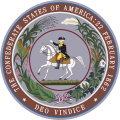President of the Confederate States of America
| President of the Confederate States of America | |
|---|---|
 | |
| Style | Mr. President |
| Residence | White House of the Confederacy |
| Appointer | Electoral College |
| Term length | Six years, nonrenewable |
| Formation | 18 February 1861 |
| First holder | Jefferson Davis |
| Final holder | Jefferson Davis |
| Abolished | 10 May 1865 |
The President of the Confederate States of America was the head of state and head of government of the Confederate States of America, which was formed from the states which declared their secession from the United States, thus precipitating the American Civil War. The only person to hold the office was Jefferson Davis. He was President from February 18, 1861, to May 10, 1865, and his Vice President was Alexander H. Stephens. Howell Cobb, as president of the Provisional Confederate States Congress, was the highest ranking Confederate official before the election of Davis, but he was not titled President of the Confederate States.
Office
According to the Confederate States Constitution, the President's office was almost entirely the same as that of the President of the United States. The President was to be:
- chosen by an electoral college from each state in the Confederacy. Each state had as many electors as they had members in the Confederate Congress (senators + representatives). The only CSA presidential election took place on November 6, 1861, when electors for the electoral college were chosen in each state. Davis, who was already in office by action of the Confederate Congress, was elected president without opposition (receiving all 109 electoral votes).[1][2]
- elected jointly with a Vice Presidential running mate. The President and Vice President could not be citizens of the same state. Like Davis, his running mate Alexander H. Stephens of Georgia received all 109 electoral votes in the November 1861 election.
- either a born citizen of the Confederacy or a born citizen of the United States born prior to December 20, 1860 and to have "been fourteen years a resident within the limits of the Confederate States, as they may exist at the time of his election."
- at least thirty-five years of age


Oath of office
Like the Oath of office of the President of the United States, the oath or affirmation of office of the President of the Confederate States was established in the Confederate States Constitution and was mandatory for a President upon beginning a term of office. The wording, almost an exact copy of the United States' version, was prescribed by the Constitution (Article II, Section 1, Clause 10), as follows:
I do solemnly swear (or affirm) that I will faithfully execute the office of President of the Confederate States, and will, to the best of my ability, preserve, protect, and defend the Constitution thereof.
As with almost every President of the United States, upon taking the oath on February 18, 1861, Jefferson Davis added the words "So help me God" to the end of the oath.
Powers
The President of the Confederacy held most of the same powers as the President of the United States. Though he could not directly propose legislation, he was given the power to nominate members of the Supreme Court of the Confederate States, ambassadors, cabinet members, and other executive officials to be approved by the Senate.
He was also Commander-in-Chief of the Armed Forces and held veto power over legislation. Unlike the U.S., the C.S. President was given the power of line-item veto, a power usually regulated to the states. Davis never used the line-item veto.
The C.S. President could be impeached by the C.S. Congress for "treason, bribery, or other high crimes and misdemeanors."
Differences
There were a few key differences between the Confederate President and the United States President:
- Unlike the United States, which allowed for indefinite re-election (until the passage of the 22nd Amendment in 1951) of both the President and Vice President after a four-year term, the Confederacy gave these offices six-year terms, but the President could not be re-elected, similar to the term limits imposed on the President of Mexico. After the war, this innovation gained considerable popularity in the re-constituted Union, most notably being endorsed by Rutherford B. Hayes in his inaugural address.[3]
- The Confederate president had the ability to subject a bill to a line-item veto, a power held by most state governors.
List of presidents
| № | Portrait | President | State | Term of office | Party | Term | Previous office | Vice President | ||
|---|---|---|---|---|---|---|---|---|---|---|
| 1 | 
|
Jefferson Davis June 3, 1808 – December 6, 1889 (Aged 81) |
Mississippi | February 18, 1861 [n 1] – May 10, 1865 |
Non-partisan | 1 (1861) |
U.S. Senator from Mississippi (1857–1861) |
Alexander H. Stephens | ||
See also
- Vice President of the Confederate States of America
- Congress of the Confederate States
- Postage stamps and postal history of the Confederate States
- Treatment of slaves in the United States
Notes
- ^ Davis was the Provisional President under the Provisional Confederate States Constitution from February 18, 1861 to February 22, 1862 when his six year term under the permanent Confederate States Constitution began.
References
External links
 Quotations related to Confederate States of America at Wikiquote
Quotations related to Confederate States of America at Wikiquote


